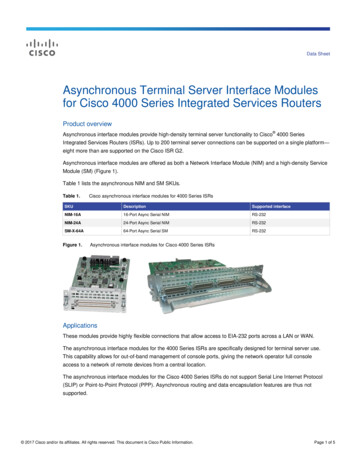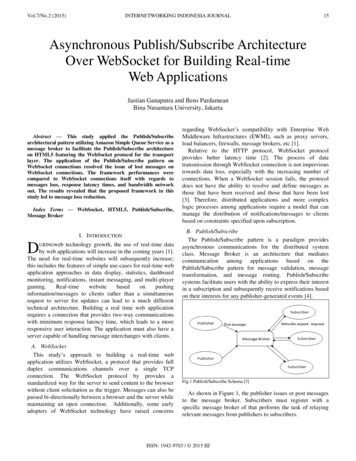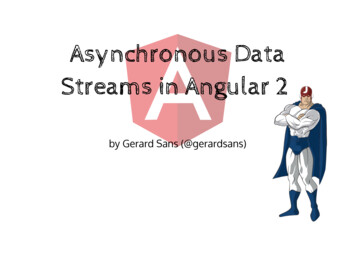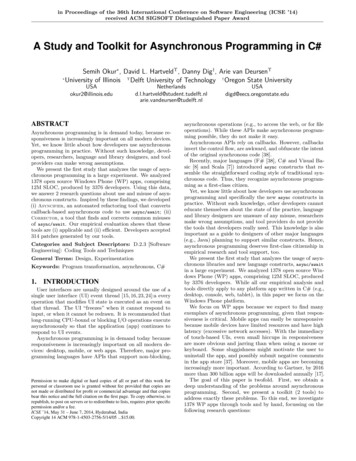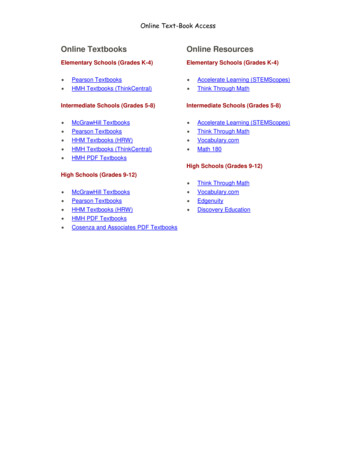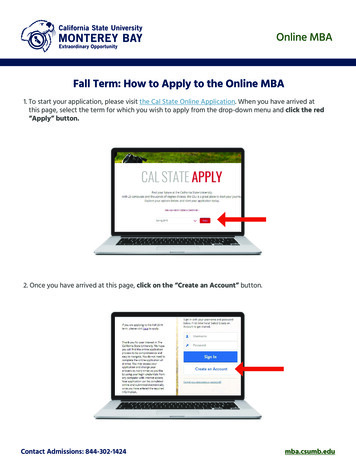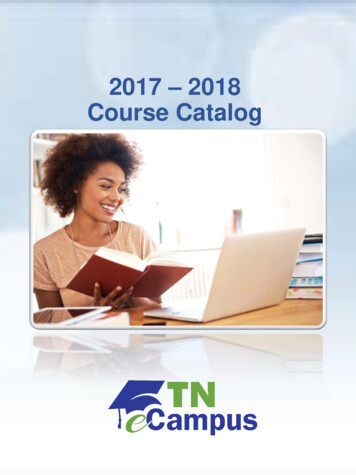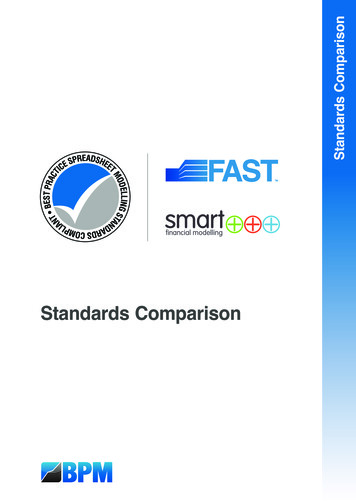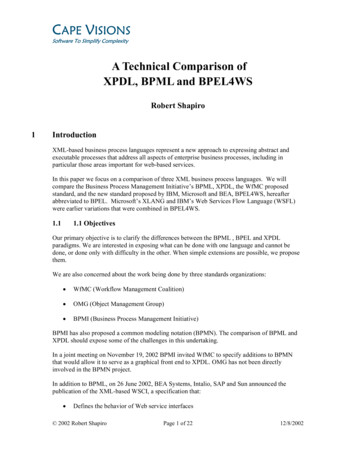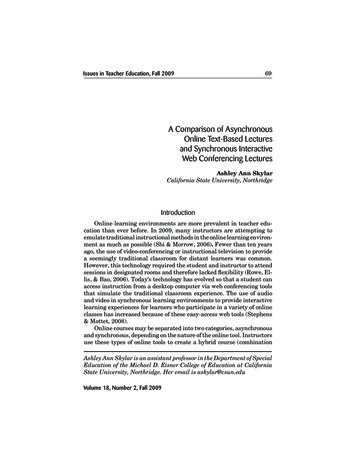
Transcription
IssuesTeacherAshleyinAnnSkylarEducation, Fall 200969A Comparison of AsynchronousOnline Text-Based Lecturesand Synchronous InteractiveWeb Conferencing LecturesAshley Ann SkylarCalifornia State University, NorthridgeIntroductionOnline learning environments are more prevalent in teacher education than ever before. In 2009, many instructors are attempting toemulate traditional instructional methods in the online learning environment as much as possible (Shi & Morrow, 2006). Fewer than ten yearsago, the use of video-conferencing or instructional television to providea seemingly traditional classroom for distant learners was common.However, this technology required the student and instructor to attendsessions in designated rooms and therefore lacked flexibility (Rowe, Ellis, & Bao, 2006). Today’s technology has evolved so that a student canaccess instruction from a desktop computer via web conferencing toolsthat simulate the traditional classroom experience. The use of audioand video in synchronous learning environments to provide interactivelearning experiences for learners who participate in a variety of onlineclasses has increased because of these easy-access web tools (Stephens& Mottet, 2008).Online courses may be separated into two categories, asynchronousand synchronous, depending on the nature of the online tool. Instructorsuse these types of online tools to create a hybrid course (combinationAshley Ann Skylar is an assistant professor in the Department of SpecialEducation of the Michael D. Eisner College of Education at CaliforniaState University, Northridge. Her email is askylar@csun.eduVolume 18, Number 2, Fall 2009
70A Comparison of Lecturesof online and traditional) or to develop a stand-alone online course. Fewstudies compare asynchronous online learning (text-based, using discussionboards) with the newer web synchronous conferencing tools (e.g., Eluminate Live, Wimba Live, Saba Centre, and Adobe Acrobat Connect).Asynchronous Online CoursesAsynchronous courses provide learners with a flexible environmentthat is self-paced with learners accessing course content using a variety of tools such as CD-ROMs, streamed prerecorded audio/video webrecordings, and audio podcasts. Communication and collaboration areenhanced via asynchronous discussions. Learners are not restricted toa set day/time for communicating, and it allows students more timeto prepare a response to a set of directions or questions. Examplesinclude the use of discussion groups (e.g., through discussion boardsvia WebCT/Blackboard or other learning management system), wikis,blogs, and e-mail. Asynchronous class sessions can provide the primarydelivery format, be used in an online course along with synchronousclass sessions, or serve as a supplement to traditional classes (Knapczyk, Frey, & Wall-Marencik, 2005). Instruction for online courses istypically asynchronous. Among the institutions offering online coursesduring 2006-2007, 92 percent reported that they offered courses usingan asynchronous format (National Center for Educational Statistics,2008). Nineteen percent used one-way prerecorded video, while sixteenpercent used correspondence only (e.g., e-mail), and twelve percent usedone-way audio transmissions (e.g., podcasting).In a study comparing asynchronous lecture notes on CD-ROMs withasynchronous lecture notes on WebCT, Skylar et al. (2005) found thatboth conditions were effective in delivering instruction. No significantdifferences between the groups for achievement and satisfaction werefound. In another study, Chen, Klein, and Minor (2008) found the useof a hybrid design using asynchronous discussions (twice a week) to beeffective in discussing modeling, communication needs, and interventionsin online early childhood courses. Knapczyk, Frey, and Wall-Marencik(2005) evaluated the use of asynchronous discussions/forums in a behavioral disorder method course. Feedback from students indicated thatthis asynchronous format provided a sense of community and increasedcollaboration with classmates.Synchronous Online CoursesMany instructors attempt to emulate traditional instructional methods in the online learning environment through the use of synchronousIssues in Teacher Education
Ashley Ann Skylar71web conferencing lectures. In real-time synchronous courses, the instructor leads the learning, and all learners are logged on simultaneously andcommunicate directly with each other (Shi & Morrow, 2006). In the past,classroom video-conferencing equipment could only be housed in designatedclassrooms, and students and the instructor had to travel to designatedsites. Today, software can be accessed from a server, and an individualcan join a synchronous interactive environment from a desktop or laptopcomputer. Examples of synchronous online formats include chat rooms,audio/video conferencing, and two-way live satellite broadcast lectures.Among the institutions offering online courses in 2006-2007, 31% percentreported that they offered the courses in a synchronous format; nineteenpercent used two-way video and audio (NCES, 2008).Synchronous courses provide online learning environments that arevery interactive and use web conferencing products such as ElluminateLive, Interwise, Wimba Live Classroom, Adobe Acrobat Connect Professional, and Saba Centra. Advantages of using a synchronous learningenvironment include real time sharing of knowledge and learning andimmediate access to the instructor to ask questions and receive answers.However, this type of environment requires a set date and time for meeting, and this contradicts the promise of “anytime, anywhere” learning thatonline courses have traditionally promoted. Synchronous online sessionsare often called web-based training, Webinar, virtual meetings, and webconferencing (Stephens & Mottet, 2008). Usually, an audio broadcast andvisual presentation, similar to slides, is accessed using an Internet browserpointed to a designated web address; sometimes web tours, break-outrooms, and application sharing are also provided (2008).Through this format, students participate using the text chat function, voice communication using a microphone, whiteboard tools, andreal time surveys called polling. In Shi and Morrow’s 2006 study, instructors described polling as an essential synchronous online component togauge student comprehension and increase student involvement in aweb conferencing environment. Recently, Offir, Lev, and Bezalel (2008)found the interaction level in a synchronous class to be a significantfactor in the effectiveness of the class. Reushle & Loch (2008) suggestthat staff training in the technical aspects of the synchronous tools, aswell as pedagogical approaches to using them, is vital for successful useof web conferencing software for online learning.The ProblemDespite the growth in the use of synchronous tools to facilitate online instruction, little is known about how people use synchronous webVolume 18, Number 2, Fall 2009
72A Comparison of Lecturesconferencing technology. The role of interactivity in web conferencingis important, particularly as it relates to its effect on student learningand satisfaction (Stephens & Mottet, 2008). Research suggests thatinteraction in a synchronous environment should result in increasedlearning. However, these arguments are more theoretical than empirically supported (Allen et al., 2004). Therefore, this research was neededto compare asynchronous online environments and synchronous webconferencing environments and their effect on the achievement andsatisfaction of students.Purpose of the StudyThe purpose of this study was to compare preservice general education and special education students’ performance and satisfaction ina course that used two types of online instruction. Two courses weredesigned to use asynchronous text-based lectures and synchronous interactive web conferencing lectures; both groups received both types ofonline instruction. In setting up this study in this manner, all studentswere exposed to both conditions, and their preferences for one conditionover another were felt to be an important aspect of the study. Additionally, with both groups participating in both conditions, it was felt thatthis would impact their perception of computer literacy skills over theduration of the semester.The study asked the following questions:1. Are there differences in performance between students accessing content presented in a synchronous interactive webconferencing lecture format compared to students that accesscontent in an asynchronous text-based lecture format?2. Would students prefer to take an online course that uses synchronous interactive web conferencing lectures or asynchronoustext-based lectures?3. Do students perceive an increased level of technology skillswhen taking an online course?MethodParticipantsForty-four preservice general education and special education students enrolled in two sections of a special education course on inclusionparticipated in this study. The course was advertised as a hybrid course,Issues in Teacher Education
73Ashley Ann Skylarso students could expect to have online components with few face-to-facesessions. The course centered on an overview of disabilities, collaboration and inclusion models, and strategies for adapting and modifyinggeneral education curriculum/materials for students with special needs.The students enrolled in these course sections during the fall of 2006.All students received both conditions: synchronous interactive webconferencing lectures and asynchronous text-based lectures. Of the 44students in this study, 36 (82%) were female and eight (18%) were male.All students had used computers for three years or more: six students12 years or more, 14 students 9-11 years, 15 students 6-8 years, andseven students 3-5 years. All students except one had indicated thatthey had access to a computer outside of school and five students indicated that they did not like completing assignments that require themto access the computer/Internet. The average age of all the students was27.4. The youngest student was 20 and the oldest student was 53. Moststudents enrolled in the class sections were graduate students workingon their teaching credential. See Table 1 for a summary of the studentdemographics.SettingIn the study, all students received both conditions. The same instructor taught both sections with each group alternating conditionsfor coverage of the content based on ten chapters in the textbook. Twosettings conditions were used for this study:Table 1:Summary of Student DemographicsCharacteristicFall 2006GenderMaleFemale368AgeMeanRangeUse of Computer in Years12 yrs or more9-11 years6-8 years3-5 yearsn 44Volume 18, Number 2, Fall 200927.420-53614155
74A Comparison of LecturesAsynchronous text-based lectures. The course presentation of contentwas asynchronous and used the course management system WebCT. Atypical class week included the students downloading text-based lecturenotes (e.g., PowerPoint, html, Word), reading a chapter in the textbookto correspond with the lecture notes, and taking a 10-item quiz at theend of the week. All content was available for students in an asynchronous format and organized by weeks 1-10 and by textbook chapter. SeeFigure 1 for a sample of how the asynchronous text-based lecture noteswere organized on WebCT. Students were encouraged to download thelecture notes and read the corresponding chapter to prepare for weeklyquizzes. In this environment, the students did not need to be presentat a set day/time in order to access online lecture notes.Students communicated with the instructor and peers in the classvia e-mail and threaded discussions. This setting was a typical formatfor an online course. The students were required to adhere to due datesfor completion of weekly quizzes which were only available Monday 8:00a.m. through Sunday 11:00 p.m. Quiz time limits were constrained to 15minutes for each 10-item quiz. This condition was used for five lecturesessions for each group of students. The instructor previously taughtFigure 1:Sample of Text-Based Lecture Materials Organized on WebCTIssues in Teacher Education
Ashley Ann Skylar75this course in this asynchronous format for the past six semesters; thus,she was very comfortable with the content of the course and conditionsof this setting.Synchronous web conferencing lectures via Elluminate Live. Thesecond learning environment consisted of real time synchronous webconferencing lectures using Elluminate Live. Students accessed lecturenote materials in the same manner as the other condition, and they wereencouraged to print these out before a synchronous web conferencinglecture. Web conferencing lectures were structured to mirror a face-toface classroom. Every other week the groups alternated this condition.The interactive nature of this environment provided a real time virtualclassroom with a variety of tools such as: two-way audio, a webcam,break-out rooms, chat window, application sharing, web tours, andstudents’ raising hands to be called upon in the chat window.Included in the learning environment were polling features for questioning students similar to a “traditional classroom clicker.” Studentsselected “yes/no, True/False, A-D” responses to questions posed by theinstructor, and the instructor was able to view and compile the results,as well as use this tool to review content and cue students who weren’tinteractive and participating. Another tool available was a whiteboardsimilar to a chalkboard that was commonly used to load a PowerPointpresentation; this included interactive word processing tools for writing/drawing/highlighting, etc. on the whiteboard. Finally, post-sessionrecordings of the lectures were provided; a URL for accessing the lecture at a later time was available for students who were absent or whowanted to review the lecture again.Web conferences were scheduled early in the week (e.g., Monday @4:00 p.m.-5
at a set day/time in order to access online lecture notes. Students communicated with the instructor and peers in the class via e-mail and threaded discussions. This setting was a typical format for an online course. The students were required to adhere to due dates for completion of weekly quizzes which were only available Monday 8:00 a.m. through Sunday 11:00 p.m. Quiz time limits were .
